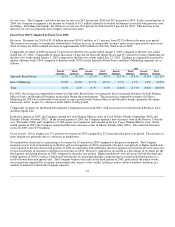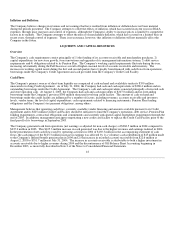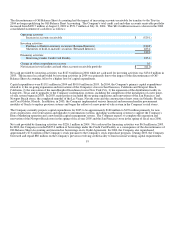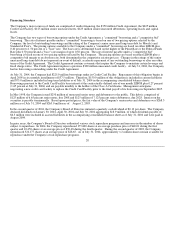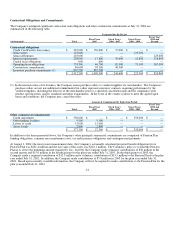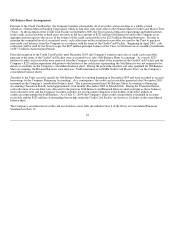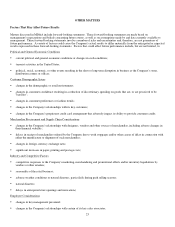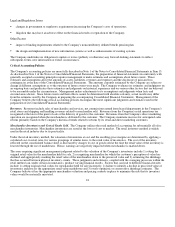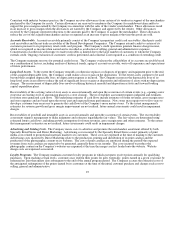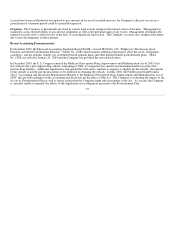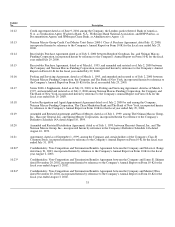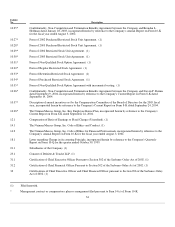Neiman Marcus 2003 Annual Report Download - page 28
Download and view the complete annual report
Please find page 28 of the 2003 Neiman Marcus annual report below. You can navigate through the pages in the report by either clicking on the pages listed below, or by using the keyword search tool below to find specific information within the annual report.
Legal and Regulatory Issues
• changes in government or regulatory requirements increasing the Company's costs of operations;
• litigation that may have an adverse effect on the financial results or reputation of the Company;
Other Factors
• impact of funding requirements related to the Company's noncontributory defined benefit pension plan;
• the design and implementation of new information systems as well as enhancements of existing systems.
The Company undertakes no obligation to update or revise (publicly or otherwise) any forward-looking statements to reflect
subsequent events, new information or future circumstances.
Critical Accounting Policies
The Company's accounting policies are more fully described in Note 1 of the Notes to Consolidated Financial Statements in Item 15.
As disclosed in Note 1 of the Notes to Consolidated Financial Statements, the preparation of financial statements in conformity with
generally accepted accounting principles requires management to make estimates and assumptions about future events. These
estimates and assumptions affect the amounts of assets, liabilities, revenues and expenses and the disclosure of gain and loss
contingencies at the date of the Consolidated Financial Statements. The amounts currently estimated by the Company are subject to
change if different assumptions as to the outcome of future events were made. The Company evaluates its estimates and judgments on
an ongoing basis and predicates those estimates and judgments on historical experience and on various other factors that are believed
to be reasonable under the circumstances. Management makes adjustments to its assumptions and judgments when facts and
circumstances dictate. Since future events and their effects cannot be determined with absolute certainty, actual results may differ
from the estimates used by the Company in preparing the accompanying Consolidated Financial Statements. Management of the
Company believes the following critical accounting policies encompass the more significant judgments and estimates used in the
preparation of its Consolidated Financial Statements.
Revenues. Revenues include sales of merchandise and services, net commissions earned from leased departments in the Company's
retail stores and shipping and handling revenues related to merchandise sold. Revenues from the Company's retail operations are
recognized at the later of the point of sale or the delivery of goods to the customer. Revenues from the Company's direct marketing
operation are recognized when the merchandise is delivered to the customer. The Company maintains reserves for anticipated sales
returns primarily based on the Company's historical trends related to returns by its retail and direct marketing customers.
Merchandise Inventories and Cost of Goods Sold. The Company utilizes the retail method of accounting for substantially all of its
merchandise inventories. Merchandise inventories are stated at the lower of cost or market. The retail inventory method is widely
used in the retail industry due to its practicality.
Under the retail inventory method, the valuation of inventories at cost and the resulting gross margins are determined by applying a
calculated cost-to-retail ratio, for various groupings of similar items, to the retail value of inventories. The cost of the inventory
reflected on the consolidated balance sheet is decreased by charges to cost of goods sold at the time the retail value of the inventory is
lowered through the use of markdowns. Hence, earnings are negatively impacted when merchandise is marked down.
The areas requiring significant management judgment related to the valuation of the Company's inventories include 1) setting the
original retail value for the merchandise held for sale, 2) recognizing merchandise for which the customer's perception of value has
declined and appropriately marking the retail value of the merchandise down to the perceived value and 3) estimating the shrinkage
that has occurred between physical inventory counts. These judgments and estimates, coupled with the averaging processes within the
retail method can, under certain circumstances, produce varying financial results. Factors that can lead to different financial results
include 1) setting original retail values for merchandise held for sale incorrectly, 2) failure to identify a decline in perceived value of
inventories and process the appropriate retail value markdowns and 3) overly optimistic or conservative shrinkage estimates. The
Company believes it has the appropriate merchandise valuation and pricing controls in place to minimize the risk that its inventory
values would be materially misstated.
24



